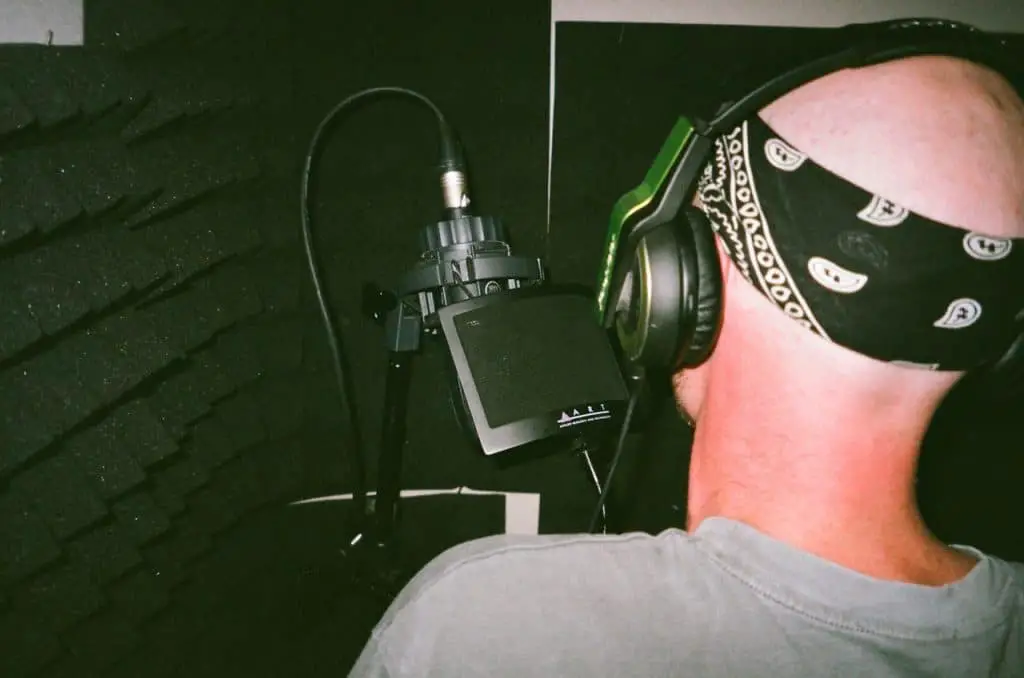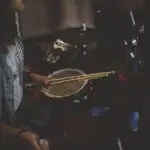
Soundproofing foam is one of the most popular materials commonly used for soundproofing music recording studios. Soundproofing foam is also called acoustic foam.
This is a great way to keep the recording space safe from outside noise and also keeps the sound from bouncing off the walls.
But if you are a complete newbie on soundproofing, you’re probably wondering how to put up soundproofing foam in the place you want to soundproof.
Well, using an acoustic foam is fairly simple. It involves just a few steps to complete. In this post, I will be sharing with you those steps. We’ll be measuring the spot where the soundproofing will be applied, cutting the foam (if necessary), attaching the foam to a piece of cardboard using adhesive (so that the foam can be moved and/or reused later without damaging it), sticking Command Strips to the cardboard backing, and finally, attaching the foam to the wall or other surface.
So, without further ado, let’s dive into the tips. I hope this helps.
Steps on How to Put Up Soundproofing Foam
As mentioned, installing soundproofing foam is quick and easy if you know the basic principles. To successfully do it, just follow these easy steps:
1. Choose the Best Location for the Soundproofing Foam
If you are using just one panel, make sure that you install it directly opposite of the speakers. This is an effective technique to deaden the sound. If you are working with a music studio, this technique will certainly help.
But of course, if you have enough budget, you can cover all the walls. This is the best solution. The drawback, of course, is the number of resources that you’ll be needing for the project.
2. Measure and Cut the Soundproofing Foam
The first and crucial first step is making correct measurements. This will help you maximize resources and minimize errors. After doing so, cut the soundproofing foam into pieces according to the desired sizes.
If you want to achieve maximum results, you can cover the whole room with soundproofing foam. But you don’t need to do that – even a single foam panel can make a big difference.
The size of the soundproofing foam needed will depend solely on the size of the room or areas you want to cover. For small recording studios though, a single foam panel will do. Just install it in the right spot.
Determine the perfect spot for the soundproofing foam to placed. If you’ll be using one panel, place it in the center of the wall – this will help achieve the best results of the project.
To accurately measure the area, use a tape measure and record the length and width of the space. Then mark the areas for easy reference throughout the process. Personally, I use a level, and mark the corners using a pencil. (If you don’t use a level, you may well end up with the soundproofing being crooked, which will annoy you until you finally move it!)
When measuring, and before cutting, it’s important to follow the old carpenter’s rule: “measure twice, cut once”. Otherwise, it’s only a matter of time before you make a wrong cut, and end up wasting your material.
After taking correct measurements, you can then cut the soundproofing foam using an Electric Carving Knife. Avoid using a regular knife if you can when cutting soundproofing foam. Using an electric carving knife will make the cutting process smooth and error-free, giving you a precise and clean edge.
3. Prepare the Surface Where the Foam Will Be Attached
But before installing the soundproofing foam, make sure that the surface of the wall is clean. You can use a cloth with alcohol to clean the wall where the soundproofing foam will be installed.
This is not just for sanitary purposes but also for making sure that the foam will stick to the wall. There is one thing to remember though – be sure to use alcohol. Using other household cleaners could leave a residue, with can interfere with the adhesion of the foam.
4. Spray an Adhesive on the Backside of the Foam
This step is only needed if you buy a soundproofing foam without adhesive. But if you buy foam that is self-adhesive, you can just skip this step.
The first step is to spray the adhesive the back of the foam to make it sticky. Adhesive spray is a perfect solution for installing soundproofing foam without causing damage to the wall.
Before applying the adhesive, be sure to put down newspapers or a dropcloth on the floor, or on the ground outside. You’ll certainly have some overspray, and you don’t want adhesive on your floor! Then, lay the soundproofing foam on the floor with the bumpy surface down. Then, in a back and forth motion, spray the adhesive on the back surface of the foam.
I like to leave the edges of the foam unsprayed. This is to prevent the edges from sticking on the cardboard, so making it easier to cut off any excess material.
5. Stick the Soundproofing Foam to the Cardboard
Now, you might be thinking why do we need cardboard in this process. Well, the cardboard will serve as protection for the wall. Secondly, it provides an easier and quicker installation. Finally, it allows you to remove the soundproofing if necessary (say, you’re moving) without damaging it, so you can re-use it.
To do this, just press the soundproofing foam with the sprayed (sticky) side down against the cardboard. Hold it for at least 30 seconds.
6. Let the Spray Adhesive Dry
Spray adhesive takes a couple of hours to completely dry. You can place the material in a well-ventilated area for 1 to 2 hours. This will be enough for the adhesive to completely dry.
7. Trim the Excess Cardboard
It is okay for the soundproofing foam to overlap the cardboard, but not OK for the cardboard to overlap the foam – it’ll just look bad once it’s installed on the wall. You can trim the excess cardboard, using scissors or some other sharp cutting tool, such as an Xacto knife. Make sure that no cardboard is noticeable from all edges.
8. Apply Command Strips on the Back of the Panel
Aside from using cardboard to protect the wall, you can also use command strips. Command strips are small adhesive rectangles that work really well for attaching things to the wall. They hold very well, and won’t damage the wall when you take them back down. The medium size command strips would work great for this purpose – they’re capable of holding up to 6 pounds, and the typical soundproofing foam panel weighs less than a pound.
Place one command strip on each corner of the backside of the cardboard, not on the foam. Then press the command strips for 15 seconds to make them stick to the cardboard.
8. Place the Foam on the Wall
After sticking all the command strips on the cardboard, you can now place the cardboard and the foam on the wall. Make sure that you accurately stick to the area you previously measured and marked.
Press the foam and the cardboard on the wall for at least 15 seconds. If you’ve done it correctly, the cardboard and the foam should remain fixed and stable on the wall where you place it.
9. Repeat the Steps Until You’re Done
Just repeat all the steps until you complete the project.
Aside from using the correct application technique, of course you also need the perfect soundproofing foam for the project. In this post, I also include the best materials you can use.
What Are the Best Soundproofing Foams to Use?
So far, we’ve covered how to put up soundproofing foam. But if you are a complete beginner in the soundproofing project, you might be wondering what are the best soundproofing foams to use for the project.
There are hundreds of products you can choose from. But I only share some of the brands that I trust.
Now, let’s get to some of the best soundproofing foams. The list is in descending order. This means that the number one on the list is what I considered the best.
5. Foamily Panels 

If you are soundproofing a small vocal booth or recording studio, you don’t need bigger materials. You might only need small ones that could cover specific small areas of the wall.
In this case, what I found perfect are the Foamily Panels. One pack of this product comes with twelve 1-square-foot patches primarily designed for sound dampening of music studios, vocal booths, or regular rooms.
This foam is not only versatile, but also fire resistant. You can easily install it on the wall even without the help of a professional. With the use of adhesive spray, you can stick the material on the wall.
Click here to check Foamily Panels on Amazon
4. Soundtrax Pro
Note: Since this article was originally published, Soundtrax Pro products don’t appear to be currently available in the U.S. We’ll update this article again, if they become available again.
If you have a limited budget for your soundproofing project, the Soundtrax Pro is perfect. This material is inexpensive. But the low price does not compromise the quality of the product.
You can use Soundtrax Pro in any soundproofing project from the music recording studio to a regular living room.
Due to its appearance, it not only soundproofs the space, but also adds an aesthetic value to it. It serves two purposes. If you are using it for your business venue (e.g. coffee shop, etc.) your customers will absolutely love the ambiance of the place.
3. Studiofoam Metro
If you are soundproofing a medium to large music studio, the Studiofoam Metro can be a perfect material. The unique shape of this material has an amazingly positive effect on audio quality. This soundproofing foam is intended for serious recording studio situations. It’s very effective at reducing noise in a sound booth; however, if price is a serious consideration, you should probably check out other options.
Click here to check Studio Metro on Amazon
2. ATS Wedges
If you are looking for a super affordable soundproofing foam for your home recording studio, you might want to try these acoustic foam wedges. But being inexpensive does not mean poor quality. It is just made for almost all soundproofing projects with minimal expenses.
We had originally included the ATS Wedges as a recommendation, but found that they are out of stock on Amazon. We don’t know when (or if) they’ll be back in stock, so in the meantime, we’re recommending the similar FStop Labs Studio Wedge Tiles. They’re they same size, 2 inches thick, and 24 inches by 24 inches, and packaged as 12 foam panels, for a very reasonable price. And, they get outstanding reviews. Check them out.
However, the noise reduction coefficient of this material is lower when compared to other premium soundproofing foams.
Nonetheless, the ATS Wedges can do a regular soundproofing project.
And at this price, they certainly deserve serious consideration.
Click here to check ATS Wedges on Amazon
1. Auralex Sonoflat
If you are looking for an incredibly effective soundproofing foam for your project, the Auralex Sonoflat is something that you need. This soundproofing foam is certainly better than other brands. These panels do a super job on absorbing high/mid range frequencies.
This material is perfect for medium-sized studios. Using this material ensures better and successful results.
Click here to check Auralex Sonoflat on Amazon
There are hundreds of soundproofing foams you can choose from. They come with different promises. However, not all of them are as great as they claimed.
I could have recommended more than six soundproofing foams in this post. But I only share six that I think effective and helpful.
Final Thoughts on How to Put Up Soundproofing Foam
Successful soundproofing requires not only effective techniques but also reliable soundproofing materials. This is the reason why I covered both the soundproofing techniques and materials here.
This guide however may not the be best one depending on the project you’re doing. Nevertheless, I hope that somehow this post provides you with the basic information you need. Happy soundproofing!
If you want to learn more about soundproofing, feel free to visit my Soundproofing Guide.








